Mental Workload as a Predictor of ATCO’s Performance: Lessons Learnt from ATM Task-Related Experiments
Abstract
1. Introduction
2. Workload and Human Performance Assessment: A Quick Overview of the State of the Art
3. Experimental Design: Methods and Materials
3.1. Materials and Instruments
3.1.1. ATCLab-Advanced Software
3.1.2. Scenarios and Indicators of Task Complexity
- The scenario was programmed with the general purpose of producing task demand variations with time on task (TOT). In other words, the amount of mental workload experienced by participants was different throughout the execution of the task in order to collect the variations caused in the different mental workload indexes and see how they would affect operator performance.
- Nine initial aircrafts were presented to participants, six of which were controlled initially by them.
- Along the execution of the scenario, participants controlled a total amount of 70 aircrafts; 50 of them travelled from external (1, 2, 3, 4, 5, 6, 7, 8, 9, 10) to internal locations (11, 12) and, conversely, 20 travelled from internal to external locations (Figure 1).
3.1.3. Tobii T120 Eye-Tracker
3.1.4. Instantaneous Self-Assessment Scale
3.2. Experimental Conditions and Participants
3.3. Procedure
- Learning stage: This first stage lasted 90 min and the main goal was to achieve proper learning and training of the ATM simulator by participants so that they could handle it comfortably before the data collection stage. First, participants had to read and sign the informed consent document and read a brief manual about the use of the simulator. Then, the participants were informed about their task goal (maintain aviation safety by preventing eventual conflicts between aircrafts) and the manual was reviewed in detail between participants and the researcher to guarantee proper understanding of the simulator use. Finally, participants trained themselves with the simulator by performing 6 training scenarios that were executed in order of difficulty. Participants could always ask questions to the researcher and consult the manual if necessary. At the end of the learning stage, the researcher checked the performance of participants to ensure their learning.
- Data collection stage: This stage took place during the day after the training stage. It lasted 120 min and the main goal was to collect empirical data of the participants during the execution of the experimental ATM scenario. More specifically, we collected performance (no. of conflicts between aircrafts) and psychophysiological (pupil size) objective data, as well as subjective mental workload reports (ISA scale). The procedure of the data collection stage for each participant was as follows: first, the researcher calibrated the eye-tracker system and told the participant to avoid head movements during the execution of the task. Then, the participant was instructed to report perceived mental workload periodically, every 5 min (during experimental condition 1), or every 2 min (during experimental condition 2). A periodic alarm would sound to advise the right time to record the ISA scale. Finally, the participant would start performing the experimental scenario for 120 min while recording. Once the experimental session finished, the participants were thanked for their participation and awarded with credits.
3.4. Experimental Room Conditions
3.5. Variables
3.5.1. Independent Variables
3.5.2. Dependent Variables
4. Overview of Key Results
4.1. Experimental Condition 1
4.2. Experimental Condition 2
5. Discussion: Challenges and Opportunities
5.1. Predicting Performance and Task Complexity through Mental Workload
5.2. Latency Differences between Measurements
5.3. Limitations, Final Conclusions and Further Research
Author Contributions
Funding
Data Availability Statement
Acknowledgments
Conflicts of Interest
Appendix A
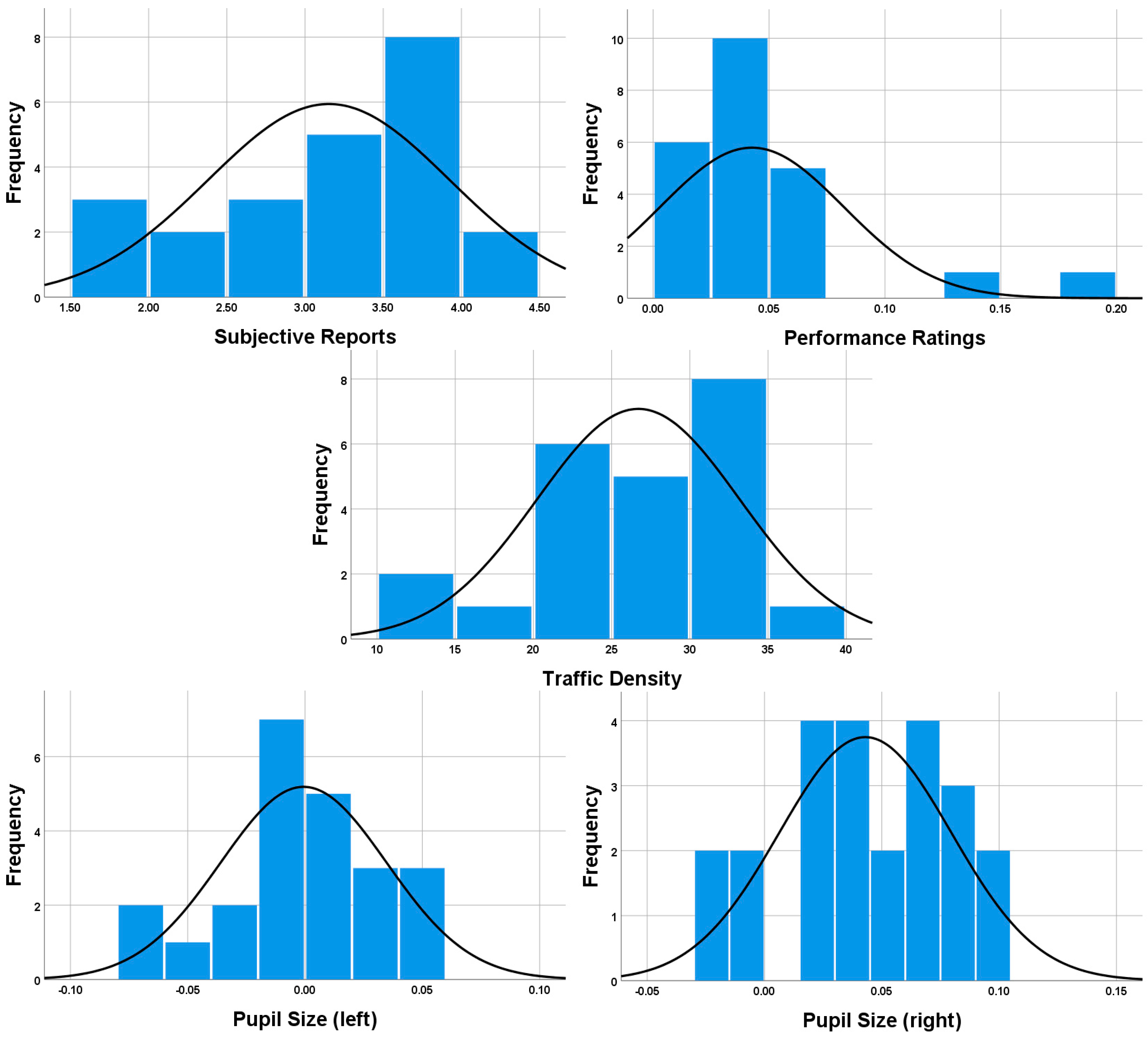
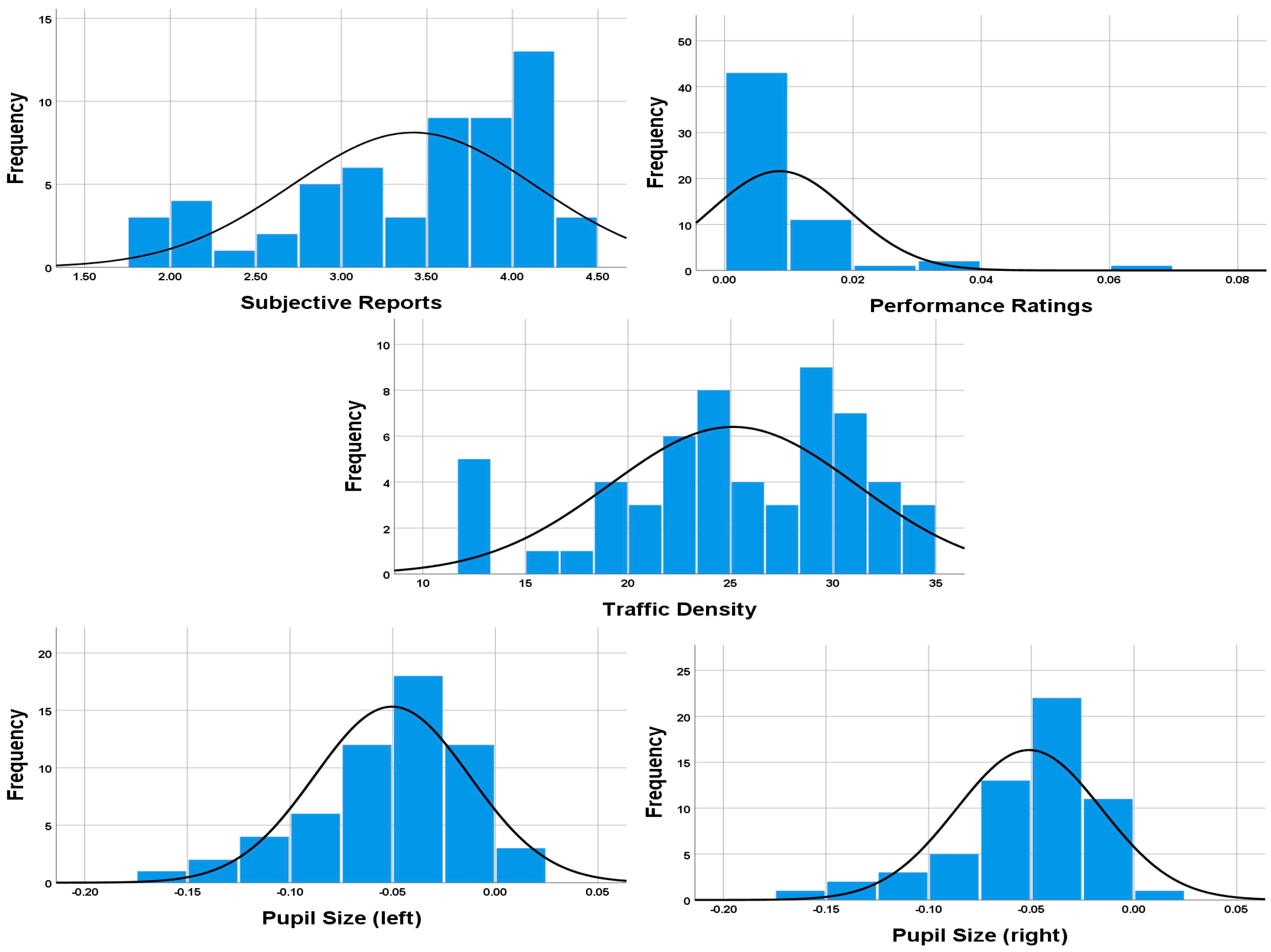
References
- Hilburn, B. Cognitive complexity in air traffic control: A literature review. EEC Note 2004, 4, 1–80. [Google Scholar]
- Histon, J.M.; Hansman, R.J. Mitigating Complexity in Air Traffic Control: The Role of Structure-Based Abstractions. Ph.D. Thesis, Department of Aeronautics and Astronautics, Massachusetts Institute of Technology, Cambridge, MA, USA, 2008. [Google Scholar]
- Cañas, J.J.; Ferreira, P.; de Frutos, P.L.; Puntero, E.; López, E.; Gómez-Comendador, F.; de Crescenzio, F.; Lucchi, F.; Netjasov, F.; Mirkovic, B. Mental workload in the explanation of automation effects on ATC performance. In International Symposium on Human Mental Workload: Models and Applications; Springer: Cham, Switzerland, 2018; pp. 202–221. [Google Scholar]
- Edwards, T.; Homola, J.; Mercer, J.; Claudatos, L. Multifactor interactions and the air traffic controller: The interaction of situation awareness and workload in association with automation. Cogn. Technol. Work. 2017, 19, 687–698. [Google Scholar] [CrossRef]
- Edwards, T.; Gabets, C.; Mercer, J.; Bienert, N. Task Demand Variation in Air Traffic Control: Implications for Workload, Fatigue, and Performance. In Advances in Human Aspects of Transportation; Stanton, N.A., Landry, S., Di Bucchianico, G., Vallicelli, A., Eds.; Springer: Cham, Switzerland, 2017; Volume 484, pp. 91–102. ISBN 9783319416816. [Google Scholar]
- Alaydi, B.; Ng, S.-I. Mitigating the Negative Effect of Air Traffic Controller Mental Workload on Job Performance: The Role of Mindfulness and Social Work Support. Safety 2024, 10, 20. [Google Scholar] [CrossRef]
- Balta, E.; Psarrakis, A.; Vatakis, A. The effects of increased mental workload of air traffic controllers on time perception: Behavioral and physiological evidence. Appl. Ergon. 2024, 115, 104162. [Google Scholar] [CrossRef] [PubMed]
- Amalberti, R. La Conduite de Systèmes à Risques; Presses Universitaires de France: Paris, France, 1996. [Google Scholar]
- de Frutos, P.L.; Rodríguez, R.R.; Zhang, D.Z.; Zheng, S.; Cañas, J.J.; Muñoz-de-Escalona, E. COMETA: An air traffic controller’s mental workload model for calculating and predicting demand and capacity balancing. In International Symposium on Human Mental Workload: Models and Applications; Springer: Cham, Switzerland, 2019; pp. 85–104. [Google Scholar]
- Netjasov, F.; Janić, M.; Tošić, V. Developing a generic metric of terminal airspace traffic complexity. Transportmetrica 2011, 7, 369–394. [Google Scholar] [CrossRef]
- Dawson, D.; Noy, Y.I.; Härmä, M.; Åkerstedt, T.; Belenky, G. Modelling fatigue and the use of fatigue models in work settings. Accid. Anal. Prev. 2011, 43, 549–564. [Google Scholar] [CrossRef]
- Sarsangi, V.; Salehiniya, H.; Hannani, M.; Marzaleh, M.A.; Abadi, Y.S.; Honarjoo, F.; Derakhshanjazari, M. Assessment of workload effect on nursing occupational accidents in hospitals of Kashan, Iran. Biomed. Res. Ther. 2017, 4, 1527–1540. [Google Scholar] [CrossRef]
- Smith, A.P.; Smith, H.N. Workload, fatigue and performance in the rail industry. In International Symposium on Human Mental Workload: Models and Applications; Springer: Cham, Switzerland, 2017; pp. 251–263. [Google Scholar] [CrossRef]
- Berberian, B.; Somon, B.; Sahaï, A.; Gouraud, J. The out-of-the-loop Brain: A neuroergonomic approach of the human automation interaction. Annu. Rev. Control 2017, 44, 303–315. [Google Scholar] [CrossRef]
- Di Flumeri, G.; De Crescenzio, F.; Berberian, B.; Ohneiser, O.; Kramer, J.; Aricò, P.; Borghini, G.; Babiloni, F.; Bagassi, S.; Piastra, S. Brain–computer interface-based adaptive automation to prevent out-of-the-loop phenomenon in air traffic controllers dealing with highly automated systems. Front. Hum. Neurosci. 2019, 13, 296. [Google Scholar] [CrossRef] [PubMed]
- Cañas, J.J.; Ferreira, P.N.P.; Puntero, E.; López, P.; López, E.; Gomez-Comendador, V.F. An air traffic controller psychological model with automation. In Proceedings of the 7th EASN International Conference: “Innovation in European Aeronautics Research”, Warsaw, Poland, 26–29 September 2016. [Google Scholar]
- Majumdar, A.; Ochieng, W. Factors affecting air traffic controller workload: Multivariate analysis based on simulation modeling of controller workload. Transp. Res. Rec. 2002, 1788, 58–69. [Google Scholar] [CrossRef]
- Wu, C.; Liu, Y. Queuing network modeling of driver workload and performance. IEEE Trans. Intell. Transp. Syst. 2007, 8, 528–537. [Google Scholar]
- Sozou, P.D.; Lane, P.C.; Addis, M.; Gobet, F. Computational scientific discovery. In Handbook of Model-Based Science; Magnani, L., Bertolotti, T., Eds.; Springer: Berlin/Heidelberg, Germany, 2017; pp. 719–734. [Google Scholar]
- Longo, L.; Leva, M.C. (Eds.) Human Mental Workload: Models and Applications: Second International Symposium, H-WORKLOAD 2018, Amsterdam, The Netherlands, 20–21 September 2018, Revised Selected Papers; Springer: Berlin/Heidelberg, Germany, 2019; Volume 1012. [Google Scholar]
- Longo, L.; Leva, M.C. (Eds.) Human Mental Workload: Models and Applications: Third International Symposium, H-WORKLOAD 2019, Rome, Italy, 14–15 November 2019, Proceedings; Springer Nature: Berlin/Heidelberg, Germany, 2019; Volume 1107. [Google Scholar]
- Longo, L.; Leva, M.C. (Eds.) Human Mental Workload: Models and Applications: 4th International Symposium, H-WORKLOAD 2020, Granada, Spain, 3–5 December 2020: Proceedings; Springer Nature: Berlin/Heidelberg, Germany, 2020; Volume 1318. [Google Scholar]
- Moustafa, K.; Luz, S.; Longo, L. Assessment of mental workload: A comparison of machine learning methods and subjective assessment techniques. In Proceedings of the International Symposium on Human Mental Workload: Models and Applications, Dublin, Ireland, 28–30 June 2017; Springer: Cham, Switzerland, 2017; pp. 30–50. [Google Scholar]
- Rizzo, L.; Longo, L. Representing and inferring mental workload via defeasible reasoning: A comparison with the NASA Task Load Index and the Workload Profile. In Proceedings of the 1st Workshop on Advances in Argumentation in Artificial Intelligence, Bari, Italy, 15–16 November 2017. [Google Scholar]
- Rizzo, L.; Dondio, P.; Delany, S.J.; Longo, L. Modeling mental workload via rule-based expert system: A comparison with NASA-TLX and workload profile. In Proceedings of the IFIP International Conference on Artificial Intelligence Applications and Innovations, Thessaloniki, Greece, 16–18 September 2016; Springer: Cham, Switzerland, 2016; pp. 215–229. [Google Scholar]
- Crevits, I.; Debernard, S.; Denecker, P. Model building for air-traffic controllers’ workload regulation. Eur. J. Oper. Res. 2002, 136, 324–332. [Google Scholar] [CrossRef]
- Moray, N. Mental workload: Its Theory and Measurement; Plenum Press: New York, NY, USA, 1979. [Google Scholar]
- Wickens, C.D. Mental workload: Assessment, prediction and consequences. In Proceedings of the International Symposium on Human Mental Workload: Models and Applications, Dublin, Ireland, 28–30 June 2017; Springer: Cham, Switzerland, 2017; pp. 18–29. [Google Scholar]
- Murai, K.; Hayashi, Y.; Okazaki, T.; Stone, L.C. Evaluation of ship navigator’s mental workload using nasal temperature and heart rate variability. In Proceedings of the 2008 IEEE International Conference on Systems, Man and Cybernetics, Singapore, 12–15 October 2008; IEEE: New York, NY, USA, 2008; pp. 1528–1533. [Google Scholar]
- De Alwis Edirisinghe, V. Estimating Mental Workload of University Students Using Eye Parameters. Master’s Thesis, NTNU, Trondheim, Norway, 2017. [Google Scholar]
- Hancock, P.A. Whither workload? mapping a path for its future development. In Proceedings of the International Symposium on Human Mental Workload: Models and Applications, Dublin, Ireland, 28–30 June 2017; Springer: Cham, Switzerland, 2017; pp. 3–17. [Google Scholar]
- Yeh, Y.H.; Wickens, C.D. The Dissociation of Subjective Measures of Mental Workload and Performance; National Aeronautics and Space Administration, Ames Research Center: Silicon Valley, CA, USA, 1984.
- Casper, P.A. Dissociations among Measures of Mental Workload: Effects of Experimenter-Induced Inadequacy. Ph.D. Thesis, Purdue University, West Lafayette, IN, USA, 1988. [Google Scholar]
- Fothergill, S.; Loft, S.; Neal, A. ATC-labAdvanced: An air traffic control simulator with realism and control. Behav Res. Methods 2009, 41, 118–127. [Google Scholar] [CrossRef] [PubMed]
- Loft, S.; Finnerty, D.; Remington, R.W. Using spatial context to support prospective memory in simulated air traffic control. Hum. Factors 2011, 53, 662–671. [Google Scholar] [CrossRef] [PubMed]
- Gee, D.G.; Bath, K.G.; Johnson, C.M.; Meyer, H.C.; Murty, V.P.; van den Bos, W.; Hartley, C.A. Neurocognitive development of motivated behavior: Dynamic changes across childhood and adolescence. J. Neurosci. 2018, 38, 9433–9445. [Google Scholar] [CrossRef]
- Yeo, G.B.; Frederiks, E.R.; Kiewitz, C.; Neal, A. A dynamic, self-regulatory model of affect and performance: Interactions between states, traits and task demands. Motiv. Emot. 2014, 38, 429–443. [Google Scholar] [CrossRef]
- Wilson, M.D.; Strickland, L.; Farrell, S.; Visser, T.A.; Loft, S. Prospective memory performance in simulated air traffic control: Robust to interruptions but impaired by retention interval. Hum. Factors 2020, 62, 1249–1264. [Google Scholar] [CrossRef]
- Marchitto, M.; Di Stasi, L.L.; Cañas, J.J. Ocular movements under taskload manipulations: In-fluence of geometry on saccades in air traffic control simulated tasks. Hum. Factors Ergon. Manuf. Serv. Ind. 2012, 22, 407–419. [Google Scholar] [CrossRef]
- Soeadyfa Fridyatama, D.A.; Suparji, S.; Sumbawati, M.S. Developing Air Traffic Control Simulator for Laboratory. TEM J. 2023, 12, 1462–1474. [Google Scholar] [CrossRef]
- Brennan, S.D. An Experimental Report on Rating Scale Descriptor Sets for the Instantaneous Self Assessment (ISA) Recorder; DRA Technical Memorandum (CAD5); DRA Maritime Command and Control Division: Portsmouth, UK, 1992; p. 92017. [Google Scholar]
- Jordan, C.S. Experimental Study of the Effect of an Instantaneous Self Assessment Workload Recorder on Task Performance; DRA Technical Memorandum (CAD5); DRA Maritime Command Control Division: Portsmouth, UK, 1992; p. 92011. [Google Scholar]
- Prandini, M.; Piroddi, L.; Puechmorel, S.; Brázdilová, S.L. Toward air traffic complexity assessment in new generation air traffic management systems. IEEE Trans. Intell. Transp. Syst. 2011, 12, 809–818. [Google Scholar] [CrossRef]
- Kartali, A.; Janković, M.M.; Gligorijević, I.; Mijović, P.; Mijović, B.; Leva, M.C. Real-time mental workload estimation using eeg. In Human Mental Workload: Models and Applications: Third International Symposium, H-WORKLOAD 2019, Rome, Italy, 14–15 November 2019, Proceedings 3; Springer International Publishing: Berlin/Heidelberg, Germany, 2019; pp. 20–34. [Google Scholar]
- Socha, V.; Hanáková, L.; Valenta, V.; Socha, L.; Ábela, R.; Kušmírek, S.; Pilmannová, T.; Tecl, J. Workload assessment of air traffic controllers. Transp. Res. Procedia 2020, 51, 243–251. [Google Scholar] [CrossRef]
- Díaz Robredo, L.A.; Robles Sánchez, J.I. La actividad electrodérmica de la piel como indicador de activación psicofisiológica en pilotos de caza españoles: Un estudio preliminar. Sanid. Mil. 2018, 74, 7–12. [Google Scholar]
- Lenné, M.G.; Jacobs, E.E. Predicting drowsiness-related driving events: A review of recent research methods and future opportunities. Theor. Issues Ergon. Sci. 2016, 17, 533–553. [Google Scholar] [CrossRef]
- Lee, C.W.; Cuijpers, P. A meta-analysis of the contribution of eye movements in processing emotional memories. J. Behav. Ther. Exp. Psychiatry 2013, 44, 231–239. [Google Scholar] [CrossRef]
- Tsai, Y.F.; Viirre, E.; Strychacz, C.; Chase, B.; Jung, T.P. Task performance and eye activity: Predicting behavior relating to cognitive workload. Aviat. Space Environ. Med. 2007, 78, B176–B185. [Google Scholar] [PubMed]
- Zheng, B.; Jiang, X.; Tien, G.; Meneghetti, A.; Panton ON, M.; Atkins, M.S. Workload assessment of surgeons: Correlation between NASA TLX and blinks. Surg. Endosc. 2012, 26, 2746–2750. [Google Scholar] [CrossRef]
- Matthews, G.; Middleton, W.; Gilmartin, B.Y.; Bullimore, M.A. Pupillary diameter and cognitive and cognitive load. J. Psychophysiol. 1991, 5, 265–271. [Google Scholar]
- Backs RW, Y.; Walrath, L.C. Eye movement and pupillary response indices of mental workload during visual search of symbolic displays. Appl. Erg. 1992, 23, 243–254. [Google Scholar] [CrossRef]
- Hyönä, J.; Tommola, J.; Alaja, A. Pupil dilation as a measure of processing load in simultaneous interpreting and other language tasks. Q. J. Exp. Psychol. 1995, 48, 598–612. [Google Scholar] [CrossRef]
- Granholm, E.; Asarnow, R.F.; Sarkin, A.J.; Dykes, K.L. Pupillary responses index cognitive resource limitations. Psychophysiology 1996, 33, 457–461. [Google Scholar] [CrossRef]
- Iqbal, S.T.; Zheng, X.S.; Bailey, B.P. Task evoked pupillary response to mental workload in human-computer interaction. In Proceedings of the ACM Conference on Human Factors in Computing Systems, Honolulu, HI, USA, 11–16 May 2024; ACM: New York, NY, USA, 2004; pp. 1477–1480. [Google Scholar]
- Verney, S.P.; Granholm, E.; Marshall, S.P. Pupillary responses on the visual backward masking task reflect general cognitive ability. Int. J. Psychophysiol 2004, 52, 23–36. [Google Scholar] [CrossRef] [PubMed]
- Porter, G.; Troscianko, T.; Gilchrist, I.D. Effort during visual search and counting: Insights from pupillometry. Q. J. Exp. Psychol 2007, 60, 211–229. [Google Scholar] [CrossRef]
- Privitera, C.M.; Renninger, L.W.; Carney, T.; Klein, S.; Aguilar, M. Pupil dilation during visual target detection. J. Vis. 2010, 10, 3. [Google Scholar] [CrossRef]
- Piquado, T.; Isaacowitz, D.; Wingfield, A. Pupillometry as a measure of cognitive effort in younger and older adults. Psychophysiology 2010, 47, 560–569. [Google Scholar] [CrossRef] [PubMed]
- Reiner, M.; Gelfeld, T.M. Estimating mental workload through event-related fluctuations of pupil area during a task in a virtual world. Int. J. Psychophysiol. 2014, 93, 38–44. [Google Scholar] [CrossRef] [PubMed]
- Hess, E.H.; Polt, J.M. Pupil size in relation to mental activity during simple problem-solving. Science 1964, 143, 1190–1192. [Google Scholar] [CrossRef] [PubMed]
- Elshtain, L.; Schaefer, T. Effects of storage load and word frequency on pupillary responses during short-term memory. Psychon. Sci. 1968, 12, 143–144. [Google Scholar] [CrossRef]
- Peavler, W.S. Pupil size, information overload, and performance differences. Psychophysiology 1974, 11, 559–566. [Google Scholar] [CrossRef]
- Bradshaw, J. Pupil size as a measure of arousal during information sing. Nature 1967, 216, 515–516. [Google Scholar] [CrossRef]
- Payne, D.T.; Parry, M.E.; Harasymiw, S.J. Percentage of pupillary dilation as a measure of item difficulty. Percept. Psychophys. 1968, 4, 139–143. [Google Scholar] [CrossRef]
- Schaefer, T.; Ferguson, J.B.; Klein, J.A.; Rawson, E.B. Pupillary responses during mental activities. Psychon. Sci. 1968, 12, 137–138. [Google Scholar] [CrossRef]
- Bradshaw, J. Pupil size and problem solving. Q. J. Exp. Psychol. 1968, 20, 116–122. [Google Scholar] [CrossRef]
- Kahneman, D. Attention and effort. In Englewood Cliffs; Prentice-Hall: Upper Saddle River, NJ, USA, 1973; Volume 1063. [Google Scholar]
- Beatty, J. Task-evoked pupillary responses, processing load, and the structure of processing resources. Psychol. Bull. 1982, 91, 276–292. [Google Scholar] [CrossRef]
- Sirois, S.; Brisson, J. Pupillometry. Wiley Interdiscip. Rev. Cogn. Sci. 2014, 5, 679–692. [Google Scholar] [CrossRef]
- Mathôt, S.; Fabius, J.; Van Heusden, E.; Van der Stigchel, S. Safe and sensible preprocessing and baseline correction of pupil-size data. Behav. Res. Methods 2018, 50, 94–106. [Google Scholar] [CrossRef] [PubMed]
- Mogford, R.H.; Guttman, J.A.; Morrow, S.L.; Kopardekar, P. The Complexity Construct in Air Traffic Control: A Review and Synthesis of the Literature; Cta Inc.: Mckee City, NJ, USA, 1995. [Google Scholar]
- Athènes, S.; Averty, P.; Puechmorel, S.; Delahaye, D.; Collet, C. ATC complexity and controller workload: Trying to bridge the gap. In Proceedings of the International Conference on HCI in Aeronautics; AAAI Press: Cambridge, MA, USA, 2002; pp. 56–60. [Google Scholar]
- Djokic, J.; Lorenz, B.; Fricke, H. Air traffic control complexity as workload driver. Transp. Res. Part C Emerg. Technol. 2010, 18, 930–936. [Google Scholar] [CrossRef]
- Muñoz-de-Escalona, E.; Cañas, J.J.; van Nes, J. Task Demand Transition Rates of Change Effects on Mental Workload Measures Divergence. In Proceedings of the International Symposium on Human Mental Workload: Models and Applications, Rome, Italy, 14–15 November 2019; Springer: Cham, Switzerland, 2019; pp. 48–65. [Google Scholar]
- Muñoz-de-Escalona, E.; Cañas, J.J.; Leva, C.; Longo, L. Task Demand Transition Peak Point Effects on Mental Workload Measures Divergence. In Proceedings of the International Symposium on Human Mental Workload: Models and Applications, Granada, Spain, 3–5 December 2020; Springer: Cham, Switzerland, 2020; pp. 207–226. [Google Scholar]
- Hancock, P.A.; Matthews, G. Workload and performance: Associations, insensitivities, and dissociations. Hum. Factors 2019, 61, 374–392. [Google Scholar] [CrossRef]
- Sweller, J. Cognitive load theory, learning difficulty, and instructional design. Learn. Instr. 1994, 4, 295–312. [Google Scholar] [CrossRef]
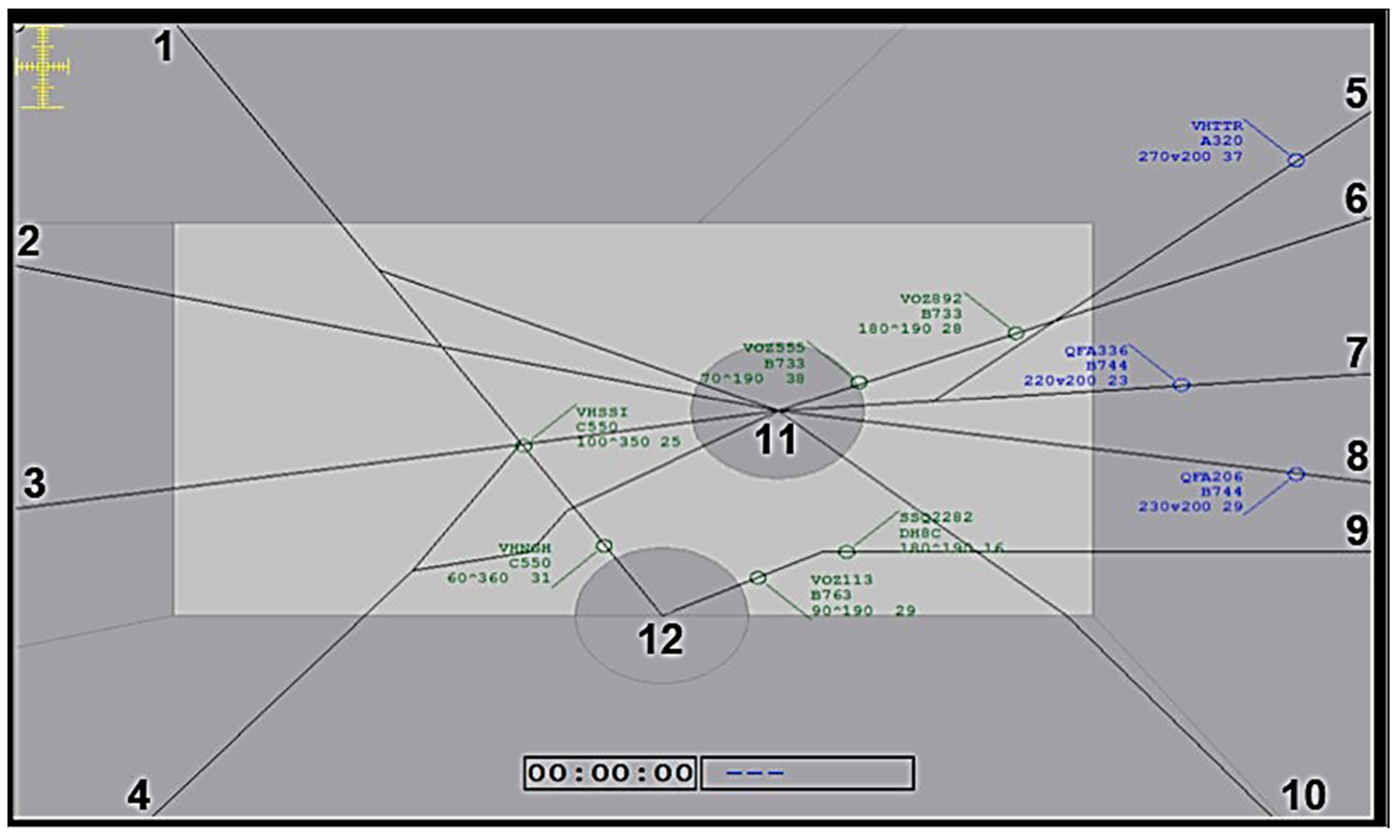

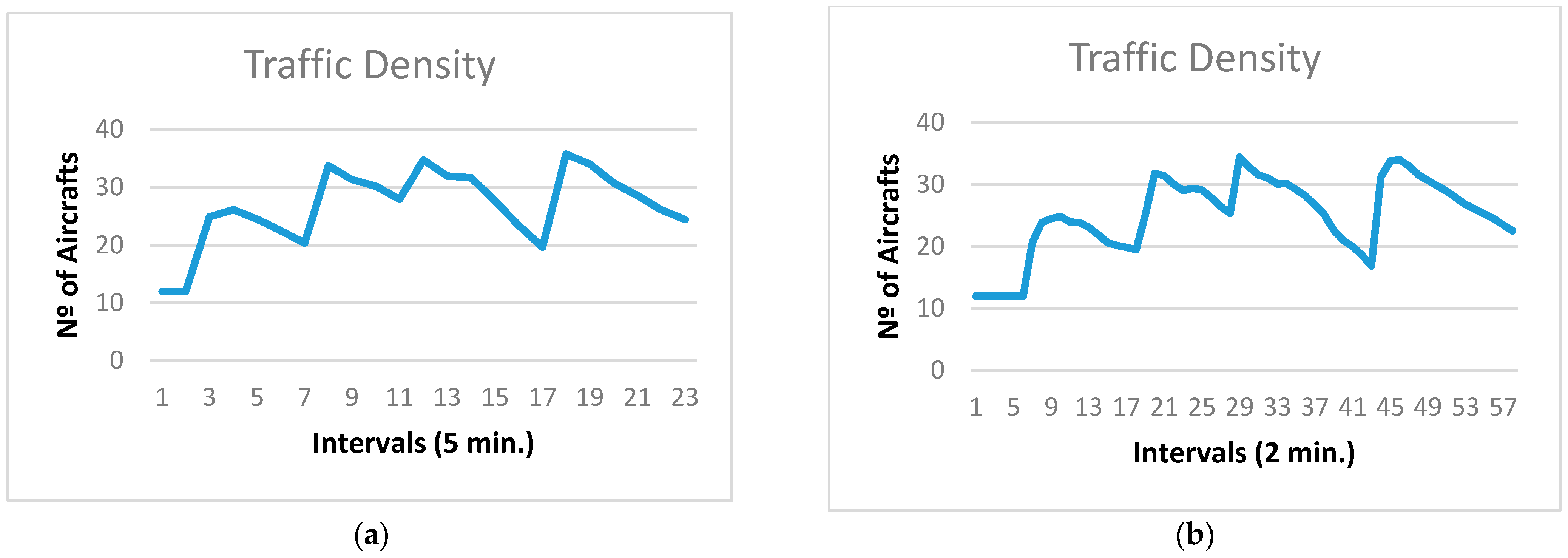
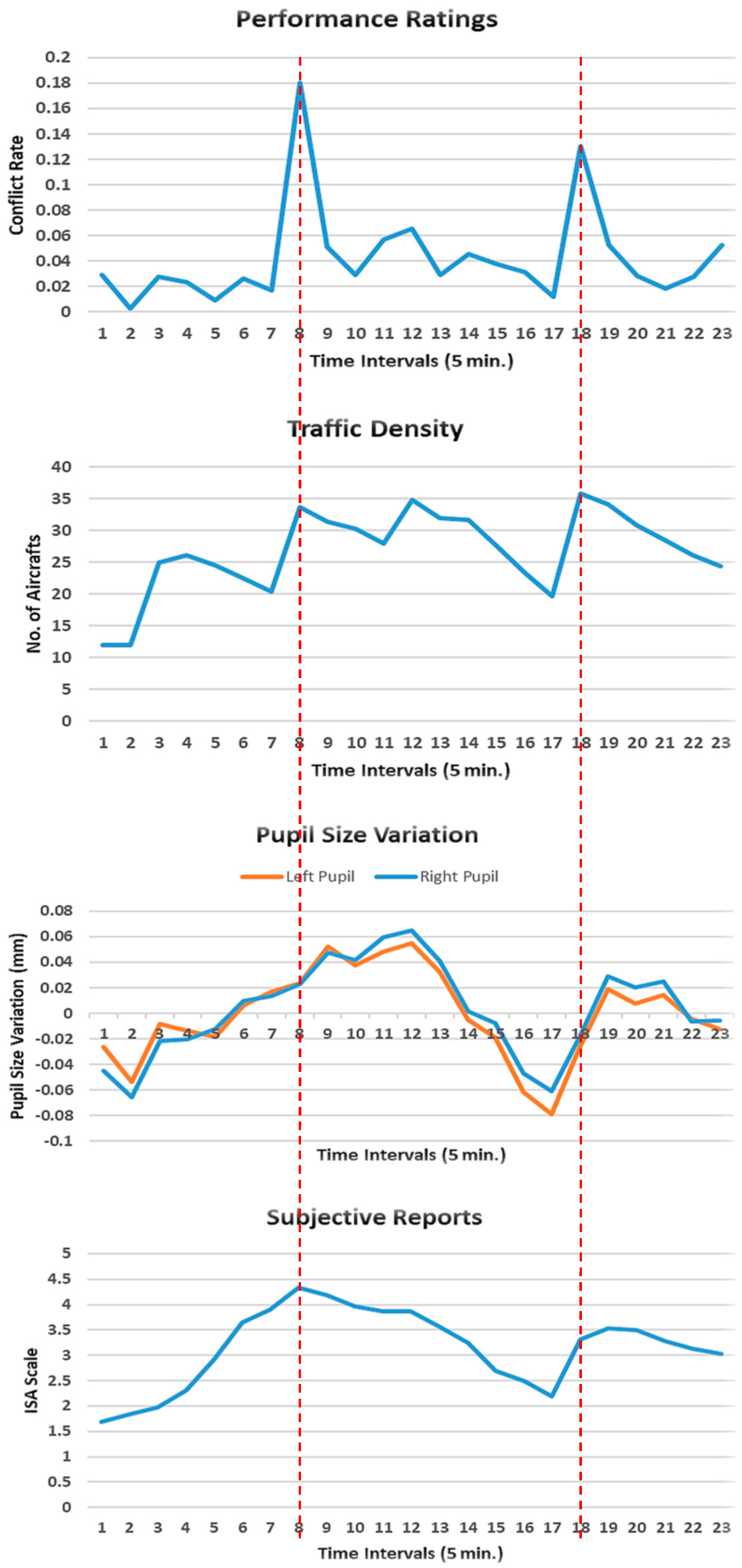
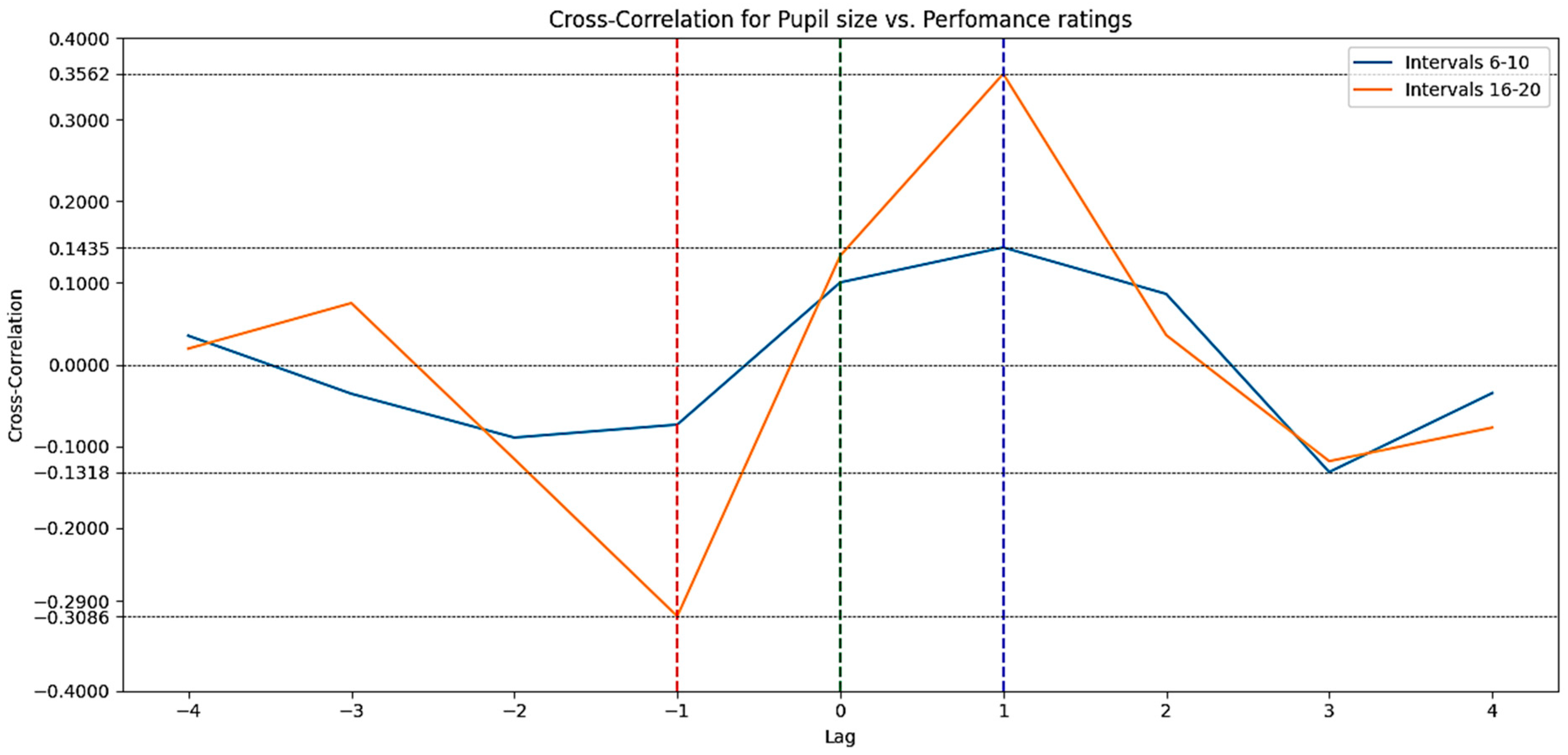
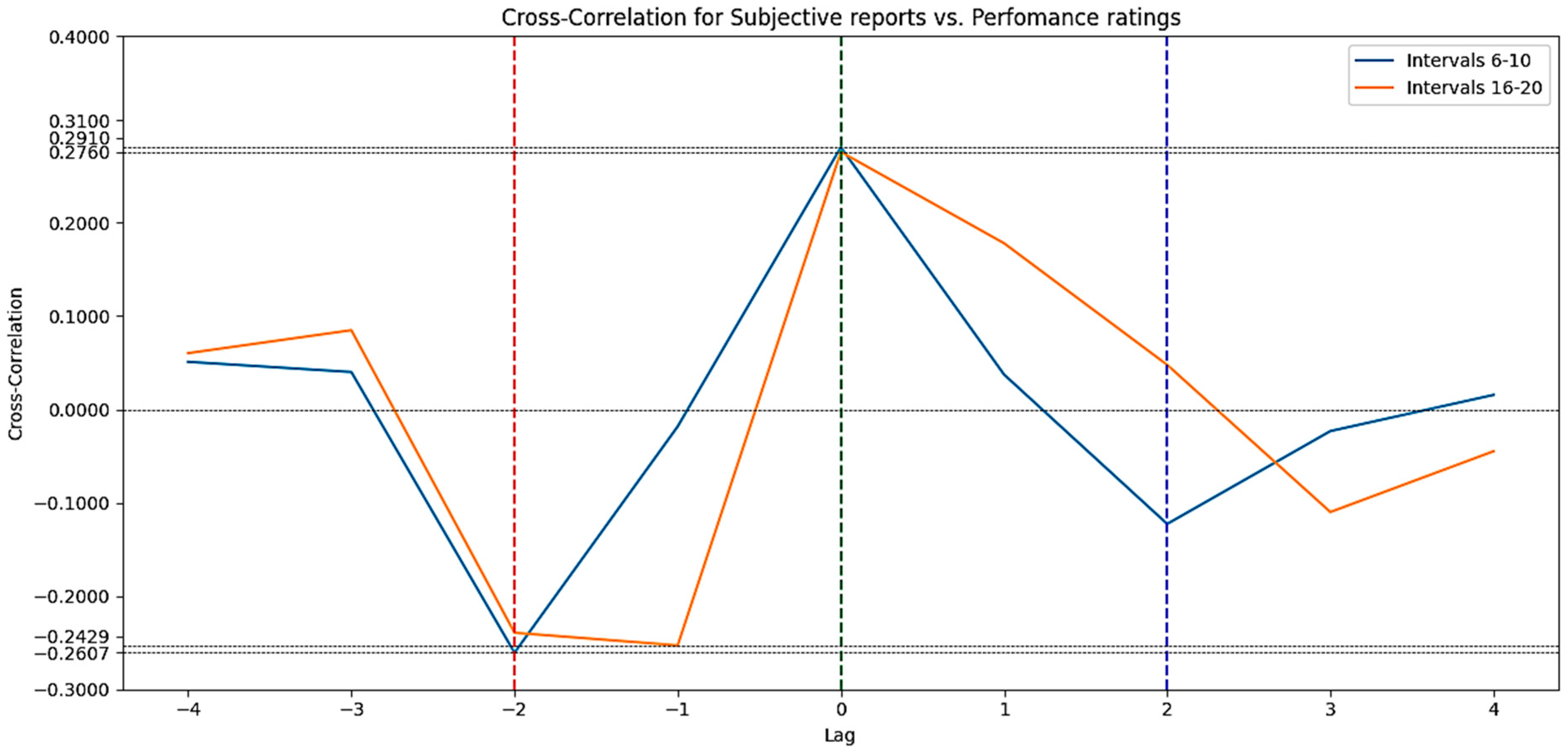
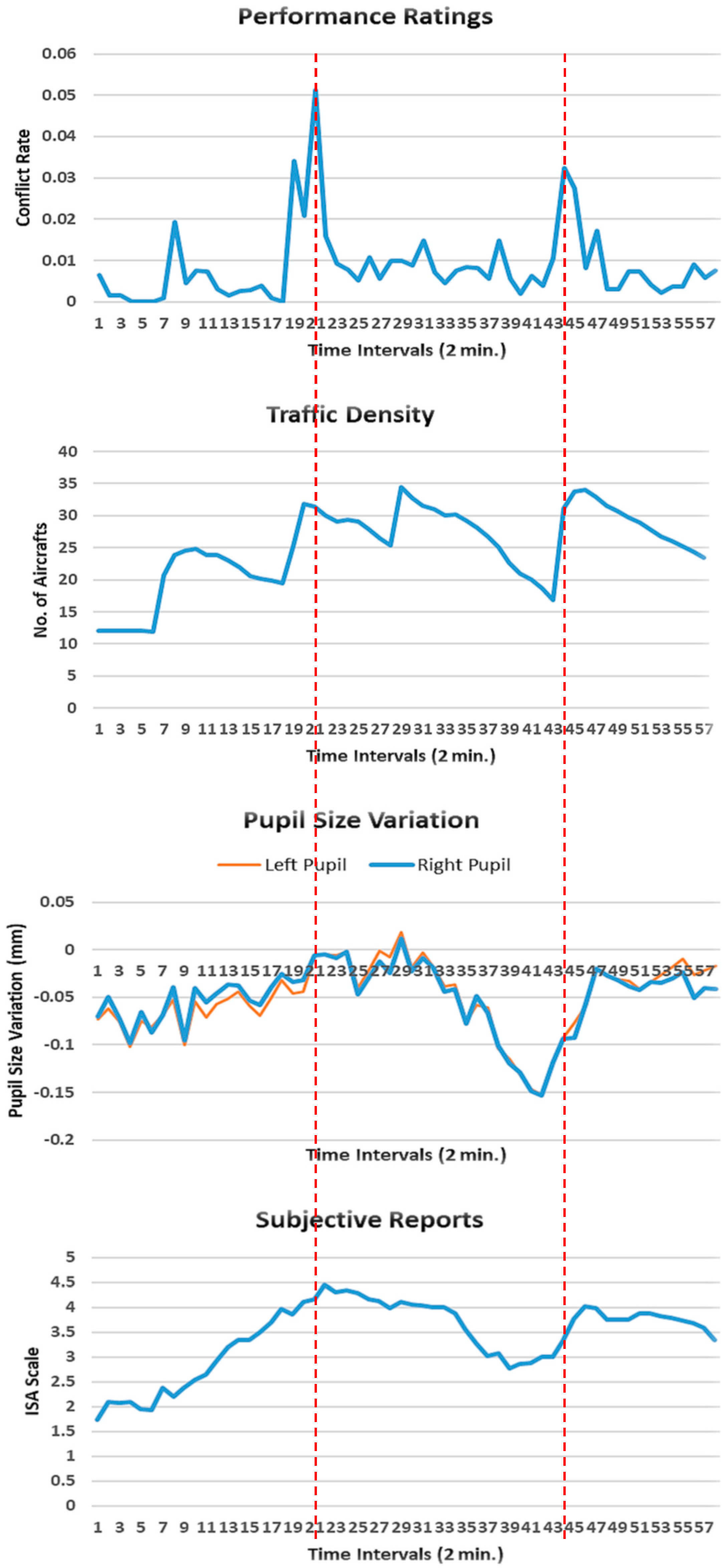

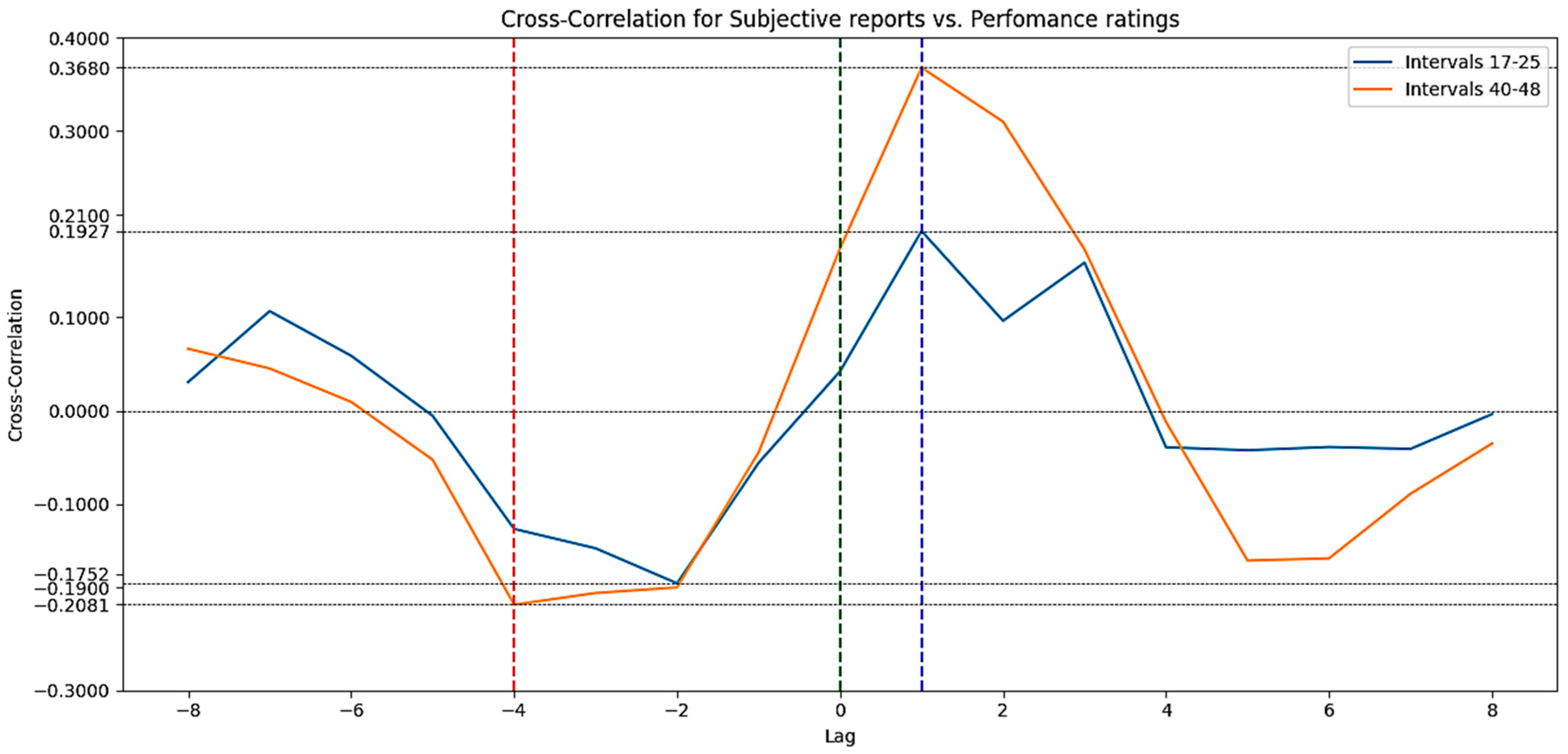
| Performance Ratings | Pupil Size (Right) | Pupil Size (Left) | Subjective Reports | Traffic Density | ||
|---|---|---|---|---|---|---|
| Performance Ratings | Spearman | 1 | 0.489 * | 0.413 | 0.485 * | 0.695 ** |
| Sig. (bilateral) | 0.018 | 0.050 | 0.019 | 0.000 | ||
| N | 23 | 23 | 23 | 23 | 23 | |
| Pupil Size (Right) | Spearman | 0.489 * | 1 | 0.963 ** | 0.875 ** | 0.656 ** |
| Sig. (bilateral) | 0.018 | 0.000 | 0.000 | 0.001 | ||
| N | 23 | 23 | 23 | 23 | 23 | |
| Pupil Size (Left) | Spearman | 0.413 | 0.963 ** | 1 | 0.867 ** | 0.602 ** |
| Sig. (bilateral) | 0.050 | 0.000 | 0.000 | 0.002 | ||
| N | 23 | 23 | 23 | 23 | 23 | |
| Subjective Reports | Spearman | 0.485 * | 0.875 ** | 0.867 ** | 1 | 0.596 ** |
| Sig. (bilateral) | 0.019 | 0.000 | 0.000 | 0.003 | ||
| N | 23 | 23 | 23 | 23 | 23 | |
| Traffic Density | Spearman | 0.695 ** | 0.656 ** | 0.602 ** | 0.596 ** | 1 |
| Sig. (bilateral) | 0.000 | 0.001 | 0.002 | 0.003 | ||
| N | 23 | 23 | 23 | 23 | 23 |
| Performance Ratings | Pupil Size (Right) | Pupil Size (Left) | Subjective Reports | Traffic Density | ||
|---|---|---|---|---|---|---|
| Performance Ratings | Spearman | 1 | 0.177 | 0.218 | 0.390 ** | 0.579 ** |
| Sig. (bilateral) | 0.184 | 0.100 | 0.003 | 0.000 | ||
| N | 58 | 58 | 58 | 58 | 58 | |
| Pupil Size (Right) | Spearman | 0.177 | 1 | 0.942 ** | 0.777 ** | 0.540 ** |
| Sig. (bilateral) | 0.184 | 0.000 | 0.000 | 0.000 | ||
| N | 58 | 58 | 58 | 58 | 58 | |
| Pupil Size (Left) | Spearman | 0.218 | 0.942 ** | 1 | 0.769 ** | 0.534 ** |
| Sig. (bilateral) | 0.100 | 0.000 | 0.000 | 0.000 | ||
| N | 58 | 58 | 58 | 58 | 58 | |
| Subjective Reports | Spearman | 0.390 * | 0.777 ** | 0.769 ** | 1 | 0.745 ** |
| Sig. (bilateral) | 0.003 | 0.000 | 0.000 | 0.000 | ||
| N | 58 | 58 | 58 | 58 | 58 | |
| Traffic Density | Spearman | 0.579 ** | 0.540 ** | 0.534 ** | 0.745 ** | 1 |
| Sig. (bilateral) | 0.000 | 0.000 | 0.000 | 0.000 | ||
| N | 58 | 58 | 58 | 58 | 58 |
Disclaimer/Publisher’s Note: The statements, opinions and data contained in all publications are solely those of the individual author(s) and contributor(s) and not of MDPI and/or the editor(s). MDPI and/or the editor(s) disclaim responsibility for any injury to people or property resulting from any ideas, methods, instructions or products referred to in the content. |
© 2024 by the authors. Licensee MDPI, Basel, Switzerland. This article is an open access article distributed under the terms and conditions of the Creative Commons Attribution (CC BY) license (https://creativecommons.org/licenses/by/4.0/).
Share and Cite
Muñoz-de-Escalona, E.; Leva, M.C.; Cañas, J.J. Mental Workload as a Predictor of ATCO’s Performance: Lessons Learnt from ATM Task-Related Experiments. Aerospace 2024, 11, 691. https://doi.org/10.3390/aerospace11080691
Muñoz-de-Escalona E, Leva MC, Cañas JJ. Mental Workload as a Predictor of ATCO’s Performance: Lessons Learnt from ATM Task-Related Experiments. Aerospace. 2024; 11(8):691. https://doi.org/10.3390/aerospace11080691
Chicago/Turabian StyleMuñoz-de-Escalona, Enrique, Maria Chiara Leva, and José Juan Cañas. 2024. "Mental Workload as a Predictor of ATCO’s Performance: Lessons Learnt from ATM Task-Related Experiments" Aerospace 11, no. 8: 691. https://doi.org/10.3390/aerospace11080691
APA StyleMuñoz-de-Escalona, E., Leva, M. C., & Cañas, J. J. (2024). Mental Workload as a Predictor of ATCO’s Performance: Lessons Learnt from ATM Task-Related Experiments. Aerospace, 11(8), 691. https://doi.org/10.3390/aerospace11080691







